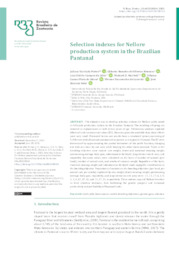Selection indexes for nellore production system in the Brazilian Pantanal.
Selection indexes for nellore production system in the Brazilian Pantanal.
Author(s): PORTES, J, V.; MENEZES, G. R. de O.; SILVA, L. O. C. da; MACNEIL, M. D.; ABREU, U. G. P. de; LACERDA, V. V. de; BRACCINI NETO, J.
Summary: The objective was to develop selection indexes for Nellore cattle raised in full-cycle production system in the Brazilian Pantanal. The resulting offspring are retained as replacements or sold at two years of age. Preliminary analyses explored effects of scale on economic values (EV). However, given the available data, these effects were very small. Presented herein are results from a simulated system consisting of 5,000 cows with all animals maintained on pasture as is typical in Pantanal. The EV were determined by approximating the partial derivatives of the profit function, changing one trait at a time, by one unit, while keeping the other traits constant. Traits in the breeding objective were mature cow weight, direct and maternal weaning weight, postweaning average daily gain, subcutaneous fat depth, longissimus muscle area, and stayability. Economic values were calculated on the basis of number of animals (per head), number of animal units, and arroba of carcasss weight. Regardless of the basis, maternal weaning weight and subcutaneous fat depth made negligible contributions to the breeding objective. Proportions of variation in the breeding objectives (per head, per animal unit, per arroba) explained by cow weight, direct weaning weight, postweaning average daily gain, stayability, and longissimus muscle area were: 13, 13, 17; 6, 1, 5; 3, 3, 4; 67, 67, 61; and 11, 17, 13, respectively. These indexes may aid Nellore breeders in their selection decisions, thus facilitating the genetic progress and increased productivity and profitability of Pantanal herds.
Publication year: 2021
Types of publication: Journal article
Unit: Embrapa Beef Cattle
Keywords: Animal genetics, Beef cattle, Bioeconomic models, Gado de Corte, Genética Animal
Observation
Some of Embrapa's publications are published as ePub files. To read them, use or download one of the following free software options to your computer or mobile device. Android: Google Play Books; IOS: iBooks; Windows and Linux: Calibre.
Access other publications
Access the Agricultural Research Database (BDPA) to consult Embrapa's full library collection and records.
Visit Embrapa Bookstore to purchase books and other publications sold by Embrapa.

